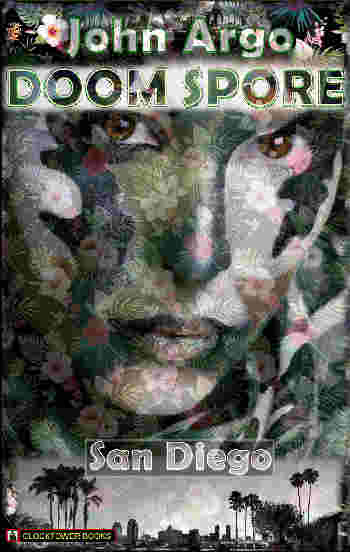Chapter 13
20.
 Three airplanes cruised slowly back and forth in the sky above San Diego, the connection unnoticed by all but three young men doing a roofing job. Three airplanes cruised slowly back and forth in the sky above San Diego, the connection unnoticed by all but three young men doing a roofing job.
As the three young men stood atop a two-story house in Serra Mesa, overlooking the great expanse of Mission Valley, they shielded their eyes from the midmorning sun and enjoyed the spectacular view. The morning marine layer fog had not burned off, so that the larger buildings were shrouded in a cottony mist right out of a science fiction movie.
The American college dropout, Hugh Milton, was new at the roofing trade. His colleagues, Fritz Juergen and Max Waldmeister, were sympathetic enough. Fritz and Max, friends since childhood, had failed as bakers in their native city of Speyer, Germany, and had immigrated to the U.S. to try their hands at a new trade. They were a pair of pale, burly cousins with curly blond hair and a watery look in their blue eyes that bespoke their fondness for beer. They needed an extra hand now and then on an extra big roof, and Hugh was their man. They lived in the same apartment complex at Parkway Plaza in La Mesa, overlooking I-8, and their alliance stemmed from a few casual parking lot greetings.
They were starting a lucrative new job. The hardest part was over—they'd spent two or three days stripping and scraping the old roof, ripping out old bent roofing nails and filling a dumpster below with curled black paper and torn grayish-blue tar shingles. Then they'd spent a day carrying heavy rectangular packages of new tiles and rolls of fresh undercoating paper, which now lay arrayed along the crest of the pitch all along the roof.
"The fog that ate San Diego." Fritz chirped the fake movie title in a German accent. They all laughed.
"But do we have enough beer?" Max asked. They all looked at the cooler which had a twelve-pack, sandwiches in water-tight baggies, and a mass of ice cubes tightly sealed and sitting in the shade behind the brick chimney.
"Yah," Hugh said in an imitation German accent, "Yah, ve heff ze Bier, unt zo ve are gutt to go." They all laughed. "Eat oll ze buildings you vant, fog monster!"
"Ja!" They all said and started working. Together, they laid strips of black undercoating. They worked their way up from the lowest edges, overlapping the long, four-foot-wide sheets so that water couldn't get under them as it ran down in a rainstorm.
As they worked, the sunlight grew more intense and the marine layer fog started rapidly to thin. They took a break, sitting on the roof with beers and sandwiches. Each had tied a red or blue bandanna around their heads, and they had plenty of colorful zinc for their noses and ears. They had spray bottles of sun block with which they often misted each other down to guard against skin cancer.
As they sat eating, they gazed out over Mission Valley, noticing several airplanes that slowly buzzed back and forth. At first, there didn't seem to be any connection between the three planes. From their high perch, the three young roofers looked southward across the mile-wide valley to the opposite rim, which averaged about 300 feet high.
Mission Valley formed through eons of erosion. During the age of dinosaurs, the region had been under shallow seawater, and the boulder-encrusted low mountains around the coastal edge of the county had been islands and sandbars on which huge saltwater lizards had basked while enormous crocodiles circled below the surface to jump on the lizards or some passing herd of dinosaurs. As the sea level had fallen (largely because millions of years of gradual cooling had built up ice packs on mountains and at the poles, thereby releasing less rain runoff back into the seas) a huge river had pushed through San Diego County. The river had been one of several draining the seas covering much of the Southwest. Today, the San Diego River was a tame meander at the low point of Mission Valley—barely a shadow of the raging giant that had gouged the mile-wide, 300 foot deep valley. It was easy to picture the scene millions of years ago, with the mile-wide river slowly subsiding, and tributary waterfalls dumping acre-feet of churning sandy water and foamy spray into the river. By the time the last sabertooth tiger had roamed through the mud flats, and the last herd of woolly mammoths had meandered past in search of forage, humans had established themselves up and down the coast. That was at the beginning of the Holocene, the present period in Earth history—the age of mankind.
Max, Hugh, and Fritz sat on the rooftop watching the planes as they zigzagged back and forth. "Man," Max said, "those look like they are crop dusting."
"Nothing is coming out the rear though," Hugh said.
"I don't see any nozzles," said Fritz dubiously.
They slowly finished their meals. To the east, where Mission Valley narrowed into Mission Gorge and then disappeared into the first of several mountain ranges—the 1000 or so foot tall Fortunas—sunlight already shone brightly as dry, warm desert air pushed the fog back out to sea. Directly below the three men, the big shapes of the football stadium, the I-15 and I-805 overpass exchanges with I-8, and numerous high rise office buildings were still partially shrouded in fog. To the west, where Mission Valley broadened into a flood plain as the river dumped into the Pacific Ocean seven miles away, a wall of fog still shrouded the Mission Valley and Fashion Valley shopping centers.
During Superbowl days, the men had seen as many as seven or eight large blimps circling like prehistoric whales around the packed stadium, and the skies had been filled with press and spectator planes. Today, there was only mild local or regional air traffic from Montgomery Field a few miles north in Kearny Mesa, and Gillespie Field a few miles east in El Cajon. Choppers from a nearby flight school rose and fell. Traffic, police, and rescue choppers periodically cut a quick line across the valley. Military craft from North Island Naval Air Station as well as the Marine Corps Air Station at Miramar were among several military fields yielding up their own air traffic. Trumping it all, of course, where the huge Boeings and Air Buses lumbering in and out of Lindbergh International at the water's edge downtown, and Rodriguez International just across the border twenty miles south. With all of that going on, it was easy to dismiss three small planes zigzagging in a systematic pattern all morning.
After an hour, one of the planes made a direct pass about 300 feet overhead. Its shadow briefly rippled across the hot roof.
Fritz exclaimed "Hey!" and stood up straight, rubbing his neck. He spotted broad black letters N followed by some numbers and a red ball with a diagonal line through it. The other planes had similar markings.
"What's the matter?" Hugh and Max said, stopping work and waiting at a crouch with hammer and roofing nails in hand.
"Something stung the back of my neck." Fritz looked at his palm, which had a light coating of something sticky and nasty. "This crap is light green or yellow, and has little black dots, thousands of them."
Max shielded his eyes and looked after the plane, which made a sharp banking turn and headed south-southwest into Mission Valley toward the huge bridge of the I-805 overpass.
Hugh wiped sweat away and reached for a water bottle. "You don't suppose they are dropping some kind of bug spray or something, do you?" As he brought the clear, sparkling plastic bottle to his mouth he froze. "Hey, this bottle is coated with something." There was a fine fuzz like faint yellowish flower spores over the whole bottle.
"It's all over the roof here," said Max, grabbing his white shirt with both hands and shaking it. "Sticky stuff!"
"Stuff doesn't want to come off," Fritz said through gritted teeth as he rubbed his elbow against his shirt and squirmed.
Hugh was too hot and tired to care much. He pulled the plastic spout on the bottle open with his teeth and drank deeply. As the water gurgled down his parched throat, he thought it had an odd, flat taste like something that has gone stale in someone's freezer ice cube tray.
After a while, Max looked up and noticed the three planes flying away in a sort of arrowhead formation, eastward over the Fortuna Mountains near Golfcrest Avenue and Mast Boulevard. The three tiny black dots disappeared over the mountain range in the direction of Santee or El Cajon, the three men tiredly thought in a brief discussion.
As quickly as the onset of the yellow ick, it seemed to blow away. Within an hour or two, the smell and stickiness no longer bothered the three men as they finished laying the under-paper and started laying rows of brand-new brick-colored shingled speckled with white gravel to deflect sunlight.
By midafternoon, when the San Diego Police and Fire Departments had processed several calls about sticky material dropping on roofs and streets, large red HazMat trucks roared out to several locations to collect samples, but the annoyance had passed. It was mentioned briefly on a late afternoon news broadcast, and one or two news choppers did low fly-bys to look at rooftops, but the issue had disappeared from local news by the five p.m. evening broadcasts.



|
  Thank you for reading. If you love it, tell your friends. Please post a favorable review at Amazon, Good Reads, and other online resources. If you want to thank the author, you may also buy a copy for the low price of a cup of coffee. It's called Read-a-Latte: similar (or lower) price as a latte at your favorite coffeeshop, but the book lasts forever while the beverage is quickly gone. Thank you (JTC). Thank you for reading. If you love it, tell your friends. Please post a favorable review at Amazon, Good Reads, and other online resources. If you want to thank the author, you may also buy a copy for the low price of a cup of coffee. It's called Read-a-Latte: similar (or lower) price as a latte at your favorite coffeeshop, but the book lasts forever while the beverage is quickly gone. Thank you (JTC).
|
TOP
|
MAIN
Copyright © 2014 by Jean-Thomas Cullen, Clocktower Books. All Rights Reserved.
|